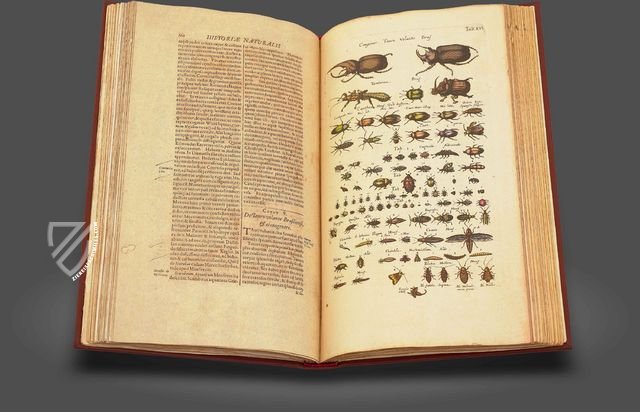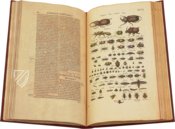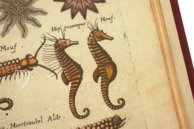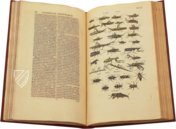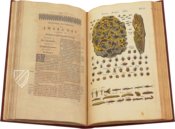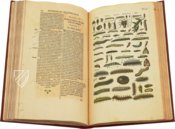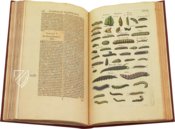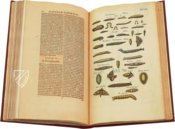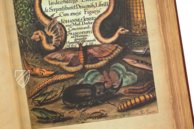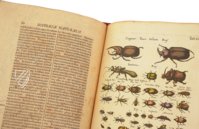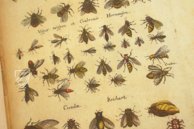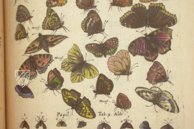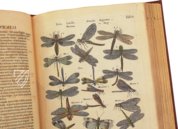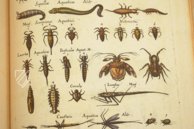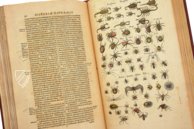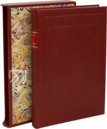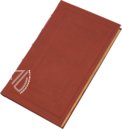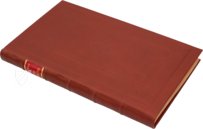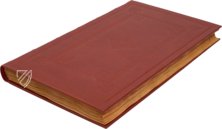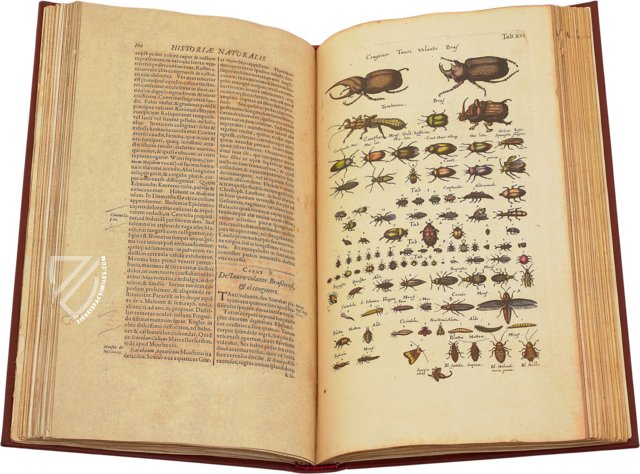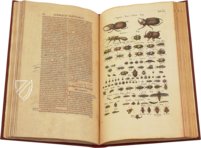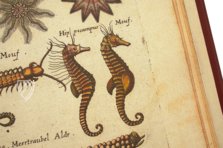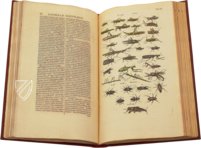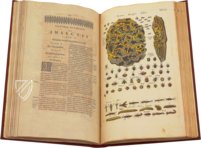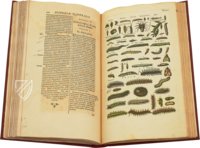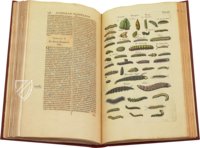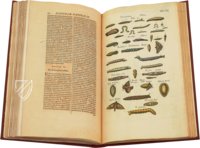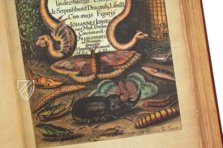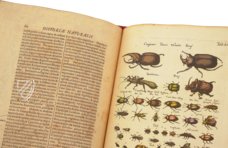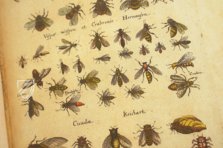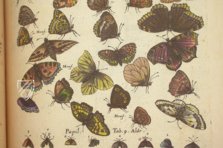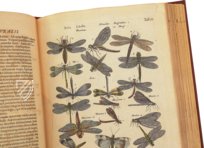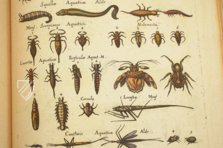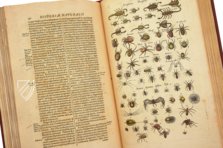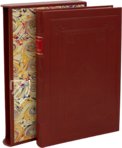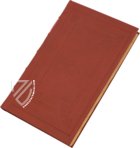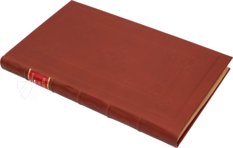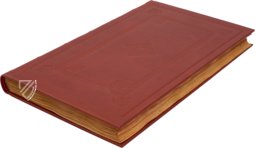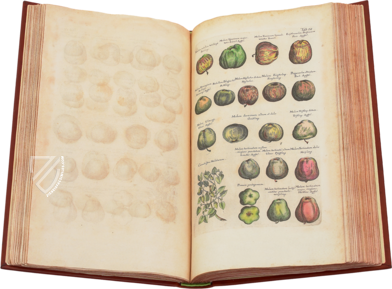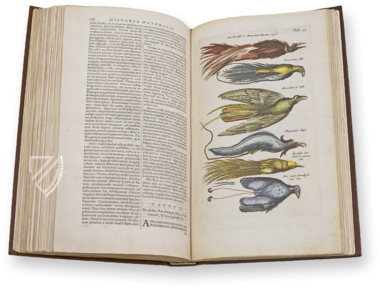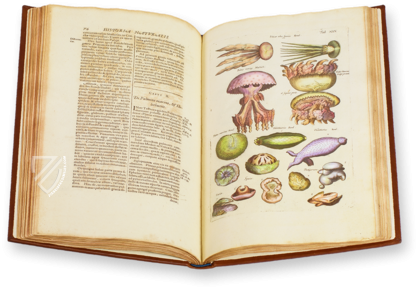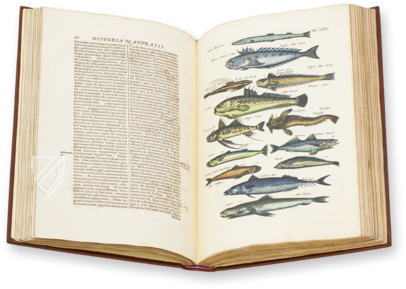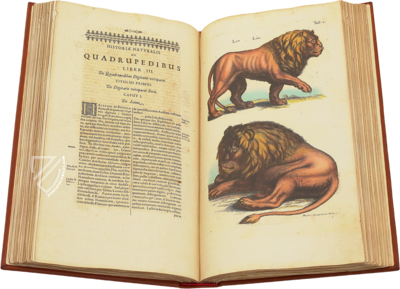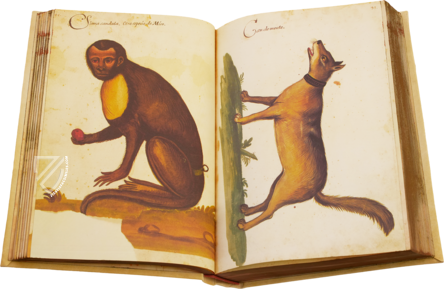Historia Naturalis: De Insectis
(3,000€ - 7,000€)
The Historia naturalis animalium, written by the Polish Renaissance man John Jonston in the mid– 17th century, was long considered to be the standard work of zoology in Europe. This “most broadly disseminated zoological handbook” experienced numerous republications and translations into other languages. The encyclopedic overview work about the history of animals assembles numerous descriptions of animals in five books. Tables with wonderful copperplate engravings by Matthäus Merian the Younger illustrate the zoological work. One volume of the series concerns itself with the Historia naturalis de exanguibus acuaticis et serpentibus, so with bloodless aquatic animals, snakes, and reptiles. As a part of the zoology of John Jonston, the book simultaneously offers a scientific and entertaining overview of insects up to the present.
Historia Naturalis: De Insectis
The Historia naturalis animalium, written by the Polish Renaissance man John Jonston in the mid– 17th century, was long considered to be the standard work of zoology in Europe. This “most broadly disseminated zoological handbook” experienced numerous republications and translations into other languages. The encyclopedic overview work about the history of animals assembles numerous descriptions of animals in five books. Tables with wonderful copperplate engravings by Matthäus Merian the Younger illustrate the zoological work. One volume of the series concerns itself with the Historia naturalis de exanguibus acuaticis et serpentibus, so with bloodless aquatic animals, snakes, and reptiles. As a part of the zoology of John Jonston, the book simultaneously offers a scientific and entertaining overview of insects up to the present.
The Renaissance Man John Jonston
John Jonston (1603–1675) was the son of Scottish parents, a doctor, and a Renaissance man from Poland. Through tours and visits of study across all of Europe, John collected a general knowledge that encompassed a variety of disciplines, which he transmitted as a tutor and tour guide to young nobles. He was famous nevertheless through his scientific-pedagogical writings concerning such diverse topics as child-rearing, philosophy and theology, history, but also medicine and mineralogy, all before the famous five-volume Historia Naturalis. Jonston did not want to write down any new knowledge, but rather to spread preexisting knowledge. Therefore, he drew on sources from ancient and contemporary authors and collected his findings in an encyclopedic work.
Standard Work of Zoology
For his incomplete magnum opus, Jonston planned a comprehensive illustrated depiction of the world of animals, plants, and people. The Historia Naturalis Animalium was printed from 1650 to 1653 in five volumes: de Piscibus et Cetis, de Exanguibus Acquaticis, de Avibus, de Quadrupedibus, and finally de Insectis and Serpentibus et Draconibus. Matthäus Merian the Younger (1621–1687), who learned from Joachim von Sandrart and Anthonis van Dyck, was involved as a copperplate engraver and publisher of the edition. He undertook the artistic design of the editions on behalf of John Jonston and published the series in the famous Frankfurt atelier of his father, Matthäus Merian the Elder, which he had taken over. The marvelous illustrations, colorfully illustrated moreover, lend the sophisticated publication its final touches.
Colorful Butterflies and Shimmering Beetles
In the book with an overview of insects, Jonston collected 28 tables with copperplate engravings on 268 pages. The work is divided in turn into several chapters. Jonston distinguished between insects of the earth, some with both feet and wings, some with feet but no wings, and finally water insects. Butterflies and caterpillars, beetles, grasshoppers, and other small animals colonize the gorgeous tables in all colors and shapes. Curiously, sea stars are also listed among the water insects. The memorable illustrations of high artistic quality along with the detailed text were surely reasons for the exceptional popularity of the Historia Naturalis across Europe.
Codicology
- Size / Format
- 268 pages / 38.0 × 22.0 cm
- Origin
- Germany
- Date
- 1653
- Epochs
- Style
- Language
- Illustrations
- 28 copperplate engravings
- Artist / School
- Johannes Jonstonus (John Jonston) (1603–1675) (author)
Matthaeus Merian The Younger (1621–1687) (engraver)
Historia Naturalis: De Insectis
Butterflies
Labelled “papillons” in French, this colorful collection of butterflies large and small exhibits a wide range of colors and patterns while maintaining a natural and realistic appearance. Butterflies have been depicted in art for thousands of years and are symbolically significant in various cultures: in Japan they represent the personification of a person’s soul, the word for butterfly in ancient Greek also came from the word “soul”, and in many cultures they symbolize rebirth.
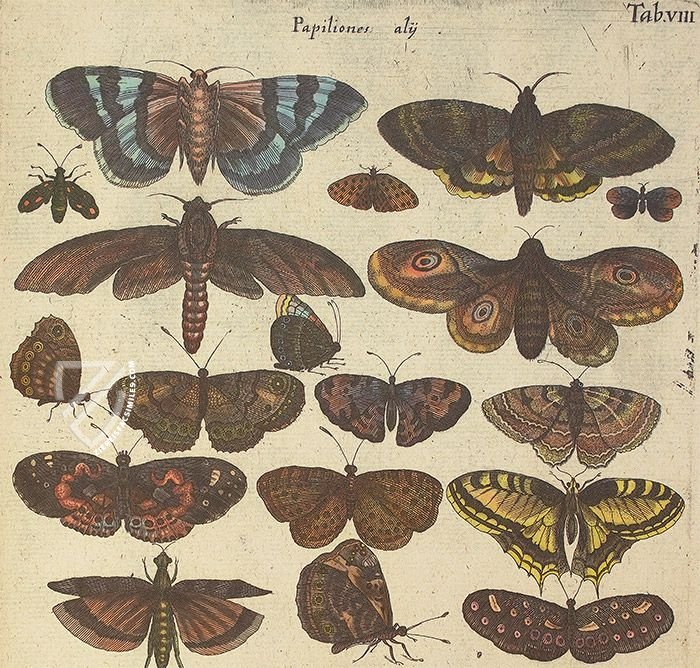
Historia Naturalis: De Insectis
Title Page
This splendidly designed page presents the title of the manuscript framed by two serpents, a flying beetle, and a large butterfly with spread wings. A wild rose bush grows on the left and a symmetrical beehive stands to the right. Flying insects such as dragonflies fill the sky, one of which has been caught in a spider’s web that does not appear to be attached to anything.
In the foreground, one’s eyes are first drawn to the great black void in the center that is an enormous rhinoceros beetle that walks among green grasshoppers, a tiny yellow scorpion, a centipede, a millipede, a worm, a blue moth, and four slugs. The signature of the engraver, Matthaeus Merian the Younger, appears in the lower right corner of the page.
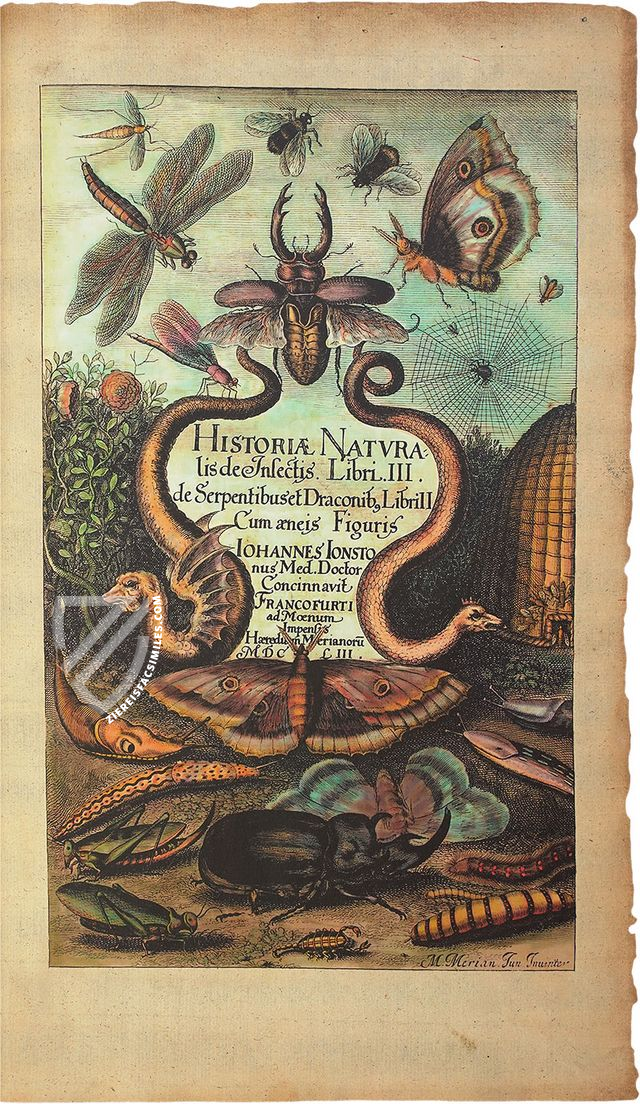
#1 Historia Naturalis: De Insectis
Language: Spanish
(3,000€ - 7,000€)
- Treatises / Secular Books
- Apocalypses / Beatus
- Astronomy / Astrology
- Bestiaries
- Bibles / Gospels
- Chronicles / History / Law
- Geography / Maps
- Saints' Lives
- Islam / Oriental
- Judaism / Hebrew
- Single Leaf Collections
- Leonardo da Vinci
- Literature / Poetry
- Liturgical Manuscripts
- Medicine / Botany / Alchemy
- Music
- Mythology / Prophecies
- Psalters
- Other Religious Books
- Games / Hunting
- Private Devotion Books
- Other Genres
- Afghanistan
- Armenia
- Austria
- Belgium
- Belize
- Bosnia and Herzegovina
- China
- Colombia
- Costa Rica
- Croatia
- Cyprus
- Czech Republic
- Denmark
- Egypt
- El Salvador
- Ethiopia
- France
- Germany
- Greece
- Guatemala
- Honduras
- Hungary
- India
- Iran
- Iraq
- Israel
- Italy
- Japan
- Jordan
- Kazakhstan
- Kyrgyzstan
- Lebanon
- Liechtenstein
- Luxembourg
- Mexico
- Morocco
- Netherlands
- Palestine
- Panama
- Peru
- Poland
- Portugal
- Romania
- Russia
- Serbia
- Spain
- Sri Lanka
- Sweden
- Switzerland
- Syria
- Tajikistan
- Turkey
- Turkmenistan
- Ukraine
- United Kingdom
- United States
- Uzbekistan
- Vatican City
- A. Oosthoek, van Holkema & Warendorf
- Aboca Museum
- Ajuntament de Valencia
- Akademie Verlag
- Akademische Druck- u. Verlagsanstalt (ADEVA)
- Aldo Ausilio Editore - Bottega d’Erasmo
- Alecto Historical Editions
- Alkuin Verlag
- Almqvist & Wiksell
- Amilcare Pizzi
- Andreas & Andreas Verlagsbuchhandlung
- Archa 90
- Archiv Verlag
- Archivi Edizioni
- Arnold Verlag
- ARS
- Ars Magna
- ArtCodex
- AyN Ediciones
- Azimuth Editions
- Badenia Verlag
- Bärenreiter-Verlag
- Belser Verlag
- Belser Verlag / WK Wertkontor
- Benziger Verlag
- Bernardinum Wydawnictwo
- BiblioGemma
- Biblioteca Apostolica Vaticana (Vaticanstadt, Vaticanstadt)
- Bibliotheca Palatina Faksimile Verlag
- Bibliotheca Rara
- Boydell & Brewer
- Bramante Edizioni
- Bredius Genootschap
- Brepols Publishers
- British Library
- C. Weckesser
- Caixa Catalunya
- Canesi
- CAPSA, Ars Scriptoria
- Caratzas Brothers, Publishers
- Carus Verlag
- Casamassima Libri
- Centrum Cartographie Verlag GmbH
- Chavane Verlag
- Christian Brandstätter Verlag
- Circulo Cientifico
- Club Bibliófilo Versol
- Club du Livre
- CM Editores
- Collegium Graphicum
- Collezione Apocrifa Da Vinci
- Comissão Nacional para as Comemorações dos Descobrimentos Portugueses
- Coron Verlag
- Corvina
- CTHS
- D. S. Brewer
- Damon
- De Agostini/UTET
- De Nederlandsche Boekhandel
- De Schutter
- Deuschle & Stemmle
- Deutscher Verlag für Kunstwissenschaft
- DIAMM
- Droz
- E. Schreiber Graphische Kunstanstalten
- Ediciones Boreal
- Ediciones Grial
- Ediclube
- Edições Inapa
- Edilan
- Editalia
- Edition Deuschle
- Edition Georg Popp
- Edition Leipzig
- Edition Libri Illustri
- Editiones Reales Sitios S. L.
- Éditions de l'Oiseau Lyre
- Editions Medicina Rara
- Editorial Casariego
- Editorial Mintzoa
- Editrice Antenore
- Editrice Velar
- Edizioni Edison
- Egeria, S.L.
- Eikon Editores
- Electa
- Emery Walker Limited
- Enciclopèdia Catalana
- Eos-Verlag
- Ephesus Publishing
- Ernst Battenberg
- Eugrammia Press
- Extraordinary Editions
- Fackelverlag
- Facsimila Art & Edition
- Facsimile Editions Ltd.
- Facsimilia Art & Edition Ebert KG
- Faksimile Verlag
- Feuermann Verlag
- Folger Shakespeare Library
- Franco Cosimo Panini Editore
- Friedrich Wittig Verlag
- Fundación Hullera Vasco-Leonesa
- G. Braziller
- Gabriele Mazzotta Editore
- Gebr. Mann Verlag
- Gesellschaft für graphische Industrie
- Getty Research Institute
- Giovanni Domenico de Rossi
- Giunti Editore
- Graffiti
- Grafica European Center of Fine Arts
- Guido Pressler
- Guillermo Blazquez
- Gustav Kiepenheuer
- H. N. Abrams
- Harrassowitz
- Harvard University Press
- Helikon
- Hendrickson Publishers
- Henning Oppermann
- Herder Verlag
- Hes & De Graaf Publishers
- Hoepli
- Holbein-Verlag
- Houghton Library
- Hugo Schmidt Verlag
- Idion Verlag
- Il Bulino, edizioni d'arte
- ILte
- Imago
- Insel Verlag
- Insel-Verlag Anton Kippenberger
- Instituto de Estudios Altoaragoneses
- Instituto Nacional de Antropología e Historia
- Introligatornia Budnik Jerzy
- Istituto dell'Enciclopedia Italiana - Treccani
- Istituto Ellenico di Studi Bizantini e Postbizantini
- Istituto Geografico De Agostini
- Istituto Poligrafico e Zecca dello Stato
- Italarte Art Establishments
- Jan Thorbecke Verlag
- Johnson Reprint Corporation
- Josef Stocker
- Josef Stocker-Schmid
- Jugoslavija
- Karl W. Hiersemann
- Kasper Straube
- Kaydeda Ediciones
- Kindler Verlag / Coron Verlag
- Kodansha International Ltd.
- Konrad Kölbl Verlag
- Kurt Wolff Verlag
- La Liberia dello Stato
- La Linea Editrice
- La Meta Editore
- Lambert Schneider
- Landeskreditbank Baden-Württemberg
- Leo S. Olschki
- Les Incunables
- Liber Artis
- Library of Congress
- Libreria Musicale Italiana
- Lichtdruck
- Lito Immagine Editore
- Lumen Artis
- Lund Humphries
- M. Moleiro Editor
- Maison des Sciences de l'homme et de la société de Poitiers
- Manuscriptum
- Martinus Nijhoff
- Maruzen-Yushodo Co. Ltd.
- MASA
- Massada Publishers
- McGraw-Hill
- Metropolitan Museum of Art
- Militos
- Millennium Liber
- Müller & Schindler
- Nahar - Stavit
- Nahar and Steimatzky
- National Library of Wales
- Neri Pozza
- Nova Charta
- Oceanum Verlag
- Odeon
- Orbis Mediaevalis
- Orbis Pictus
- Österreichische Staatsdruckerei
- Oxford University Press
- Pageant Books
- Parzellers Buchverlag
- Patrimonio Ediciones
- Pattloch Verlag
- PIAF
- Pieper Verlag
- Plon-Nourrit et cie
- Poligrafiche Bolis
- Presses Universitaires de Strasbourg
- Prestel Verlag
- Princeton University Press
- Prisma Verlag
- Priuli & Verlucca, editori
- Pro Sport Verlag
- Propyläen Verlag
- Pytheas Books
- Quaternio Verlag Luzern
- Reales Sitios
- Recht-Verlag
- Reichert Verlag
- Reichsdruckerei
- Reprint Verlag
- Riehn & Reusch
- Roberto Vattori Editore
- Rosenkilde and Bagger
- Roxburghe Club
- Salerno Editrice
- Saltellus Press
- Sandoz
- Sarajevo Svjetlost
- Schöck ArtPrint Kft.
- Schulsinger Brothers
- Scolar Press
- Scrinium
- Scripta Maneant
- Scriptorium
- Shazar
- Siloé, arte y bibliofilia
- SISMEL - Edizioni del Galluzzo
- Sociedad Mexicana de Antropología
- Société des Bibliophiles & Iconophiles de Belgique
- Soncin Publishing
- Sorli Ediciones
- Stainer and Bell
- Studer
- Styria Verlag
- Sumptibus Pragopress
- Szegedi Tudomànyegyetem
- Taberna Libraria
- Tarshish Books
- Taschen
- Tempus Libri
- Testimonio Compañía Editorial
- Thames and Hudson
- The Clear Vue Publishing Partnership Limited
- The Facsimile Codex
- The Folio Society
- The Marquess of Normanby
- The Richard III and Yorkist History Trust
- Tip.Le.Co
- TouchArt
- TREC Publishing House
- TRI Publishing Co.
- Trident Editore
- Tuliba Collection
- Typis Regiae Officinae Polygraphicae
- Union Verlag Berlin
- Universidad de Granada
- University of California Press
- University of Chicago Press
- Urs Graf
- Vallecchi
- Van Wijnen
- VCH, Acta Humaniora
- VDI Verlag
- VEB Deutscher Verlag für Musik
- Verlag Anton Pustet / Andreas Verlag
- Verlag Bibliophile Drucke Josef Stocker
- Verlag der Münchner Drucke
- Verlag für Regionalgeschichte
- Verlag Styria
- Vicent Garcia Editores
- W. Turnowski Ltd.
- W. Turnowsky
- Waanders Printers
- Wiener Mechitharisten-Congregation (Wien, Österreich)
- Wissenschaftliche Buchgesellschaft
- Wissenschaftliche Verlagsgesellschaft
- Wydawnictwo Dolnoslaskie
- Xuntanza Editorial
- Zakład Narodowy
- Zollikofer AG

